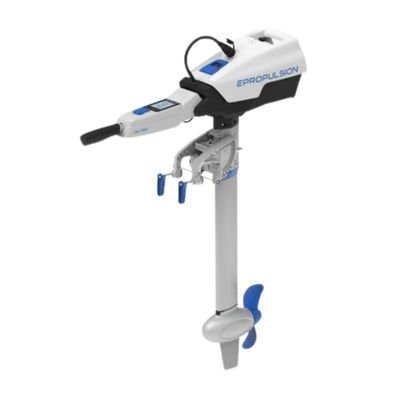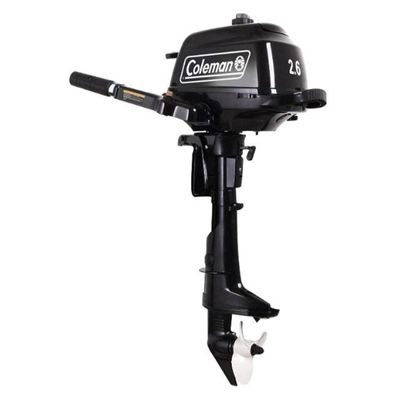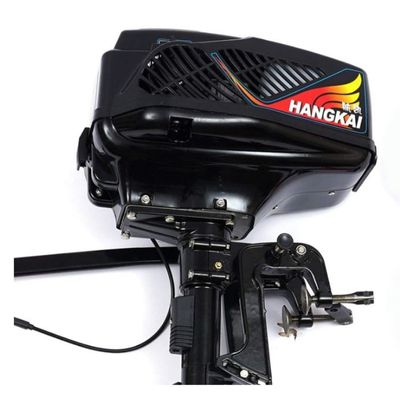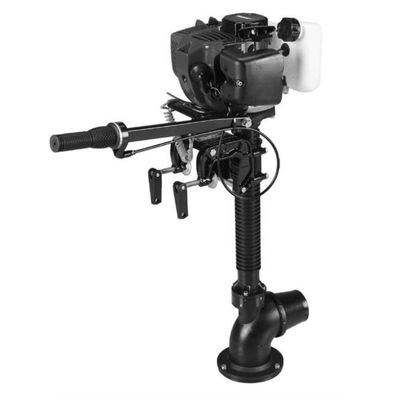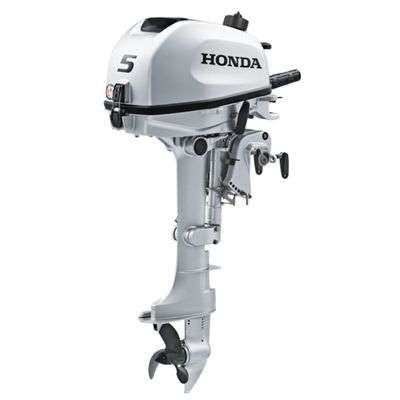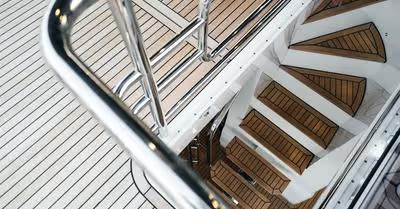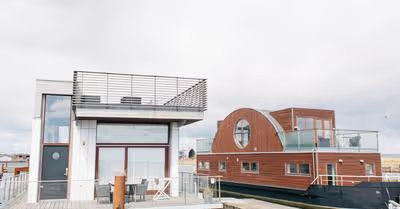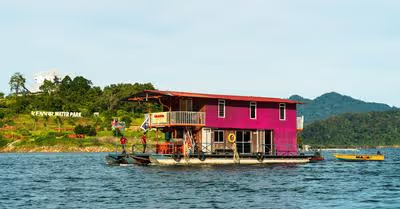
Key Takeaways
- The three best inflatable boat motors are the Newport Vessels NV-Series Motor, Spirit 1.0 Evo Outboard Motor, and Coleman Powersports Outboard Motor.
- The average rigid inflatable boat can reach 5-15 miles per hour. With the proper design and a larger outboard gas engine, it’s possible to reach 20-25 mph.
- We recommend a motor with 3-5 horsepower for an inflatable boat. Anything higher than this is likely unnecessary and too powerful for this boat type.
If you're an adventurous outdoor enthusiast who loves spending time on the water, choosing the right motor for your inflatable boat is essential.
The best motors for inflatable boats are
- Newport Vessels NV-Series Motor
- Spirit 1.0 Evo Outboard Motor
- Coleman Powersports Outboard Motor
- Aohuada Outboard Motor
- Sea Dog Water Sports Motor
- Honda 5 HP Outboard Motor
It can be confusing trying to figure out what type of motor will best suit an individual boat's needs. This guide aims to provide helpful advice and information about selecting the ideal motor. Our rankings are based on factors such as performance, efficiency, and safety. We'll also give our readers tips on motor maintenance and how to use them correctly.
6 Best Motor For Inflatable Boats
If you plan to take your inflatable boat out for fun in the sun, you’ll need the right motor to power it. While numerous types of motors are available, choosing the best one can be challenging.
I struggled to find the right model at first. Some motors can be too big and powerful, which can be dangerous for a lightweight inflatable boat. Several important things should be considered when selecting an engine for this type of boat.
Luckily, I was able to test numerous options and find seven amazing motors worth using. Keep reading below to decide which one is the best choice.
Newport Vessels NV-Series - Best Trolling Motor
Newport Vessels NV-Series
In terms of performance and pricing, the Newport Vessels NV-Series is the best trolling motor available for inflatable boats and small vessels. It’s also available in multiple styles with different thrust ratings for different boat sizes.
- 36-pound thrust - 30″ shaft
- 46-pound thrust - 30″ shaft
- 55-pound thrust - 30″ shaft
- 62-pound thrust - 36″ shaft
- 86-pound thrust - 36″ shaft
Preferably, 40-80 pounds of thrust is the sweet spot to aim for. But this ultimately depends on the boat size and total weight. This 12-volt motor has excellent efficiency and a solid design to provide reliable long-term durability.
This is the best outboard motor. It also has a 5 LED battery meter, a 6-inch telescoping handle, and a three-blade propeller. There are eight speeds, including five forward and three backward. The speed will max out at 4-5 miles per hour.
This is not the ideal motor for speed demons. But it’s safe, consistent, and affordable. We highly recommend it for smaller and lighter inflatable boats.
Benefits of this Motor
- Variety of options to choose from with different thrust and shaft length
- One of the easiest to install trolling motors
- Lightweight design
- Solid low-end torque
- 2-year warranty
Drawbacks of this Motor
- Not built for speed
- Seals can wear out faster than expected in the saltwater
Spirit 1.0 Evo Electric Outboard Motor - Best Electric Motor
Spirit 1.0 Evo Electric Outboard Motor
The Spirit 1.0 Evo Electric Outboard Motor is one of the best electric outboard motors on the market, and we rank it as the best electric motor option. This 3HP electric outboard works well on small dinghies too.
This amazing motor can provide up to 80 lbs of thrust with a peak power output of 1,276 Wh, making it ideal for powering small-sized to mid-sized inflatable boats. There are also dual power ports with solar charging.
This is one of the most innovative inflatable boat motor options too. It has a hydro generation function for more sustainable use. We could go 22 miles at a cruising speed of 4.5 mph on a single charge.
The digital operating system is one of the easiest to use. The digital display gives us full control over the electric start, kill switch, throttle changing, and maximum power adjustments.
The 19-pound battery is rechargeable and lightweight. It also has positive buoyancy to protect against any potential accidents. Finally, the folding design makes it extremely portable and easy to transport.
Benefits of this Motor
- Low maintenance and no fumes
- Lightweight and easy to move around
- Quiet yet powerful operation
- Compact design allows for easy installation in any inflatable boat
Drawbacks of this Motor
- Cannot be used for boats with heavier loads or faster speeds
Coleman Powersports 2.6 hp Outboard Motor - Best Gas Motor
Coleman Powersports 2.6 hp Outboard Motor
I recently purchased the Coleman Powersports Outboard Motor for my small inflatable boat and couldn't be happier. This gas outboard motor has great power and is lightweight enough to transport easily.
I was also impressed by how quietly it runs compared to other motors of similar size. The fuel
efficiency is also great. It takes 24 gallons and I never have to worry about running out while on the water.
This motor packs a punch. The 1-cylinder OHV engine easily produces up to 2.6 horsepower of thrusting power. The lightweight design makes it incredibly easy to transport from site to site and removes much of the strain normally associated with carrying outboard motors.
I can confidently say this is one of the best gas outboard motors for any inflatable boat owner. I loved this motor's easy-start TCI ignition feature and 4-stroke design.
Benefits of this Motor
- Lightweight and compact design
- Simple to install and use
- Powerful 2.6 hp engine
- Specially designed for inflatable boats
- Low emissions and fuel efficiency
Drawbacks of this Motor
- More expensive to maintain because of fuel costs
- Limited speed
Aohuada 2 Stroke Outboard Motor - Best Budget Motor
Aohuada 2 Stroke Outboard Motor
For inflatable boat owners on a budget, we recommend the Aohuada 2 Stroke Outboard Motor. This two-stroke motor is perfect for inflatable boats and provides excellent performance for its price.
It can provide a maximum power output of 3.6 horsepower. It also features a single-cylinder, air-cooled design with a displacement of 55ccs. Equipped with high-quality components such as dual ball bearings, oil seals, and stainless steel screws, this motor is built to last.
This outboard comes with both forward and reverse gears. We can maneuver the boat easily. Despite the larger fuel capacity, this motor does remain lightweight and easy to transport or install without weighing the boat down.
The superior engine water cooling system and CDI ignition system are upgraded features of this model. The only thing to beware of is the loud noise when it runs for longer periods.
Benefits of this Motor
- Low cost and affordable price point
- Smooth operation with sufficient power to get the boat moving quickly
- Maintenance requirements are relatively low
Drawbacks of this Motor
- Known for its high noise levels during use
Sea Dog Water Sports Motor - Best 2-Stroke Motor
Sea Dog Water Sports Motor
The Sea Dog Water Sports Motor is perfect for powering small inflatable watercraft such as dinghies, canoes and kayaks on any lake or river. Its lightweight design allows easy mounting on any inflatable boat and makes transportation a breeze.
It's also incredibly quiet, creating minimal sound when in use, so we can enjoy those peaceful moments out on the water without disturbing anyone else. It can work in both freshwater and saltwater conditions.
This two-stroke motor has been designed to provide maximum power and performance while keeping your vessel running smoothly and efficiently. It comes with a 1-year warranty.
This motor is built with quality components that ensure long-lasting durability no matter how hard it’s used or how often it’s operated under tough marine conditions. The integrated circuit protection prevents mechanical burnouts and has a quick-start electric ignition system.
Benefits of this Motor
- Minimal noise
- Excellent efficiency and smooth operation
- Lightweight design
- Long-lasting durable with adequate power
Drawbacks of this Motor
- Expensive price tag
Honda 5 HP Outboard Motor - Best 4-Stroke Motor
Honda 5 HP Outboard Motor
If price is not a problem, It’s hard to go wrong with the Honda 5 HP Outboard Motor. This 4-stroke is lightweight, compact, and extremely easy to install.
The folding tiller handle makes transporting it simple. It also has a full forward, neutral, and reverse shifting system with shallow water driving settings. The throttle control is one of the most precise I’ve found too.
This is easily one of the best gas outboard motor options available today. There’s a 6-amp charging system to charge devices and it has a 1.5L fuel tank. That’s enough fuel for 40 minutes of wide-open throttle movement.
The motor mount has excellent durability too. And if things feel shaky, use the one-push stop switch to halt movement with a safe shutdown. This motor is a good way to improve an inflatable boat's performance.
Benefits of this Motor
- Easy starting system
- 5-year warranty
- Corrosion protection system
Drawbacks of this Motor
- Packs a lot of power for an inflatable watercraft
- High pricing
- Expensive to repair
Electric Vs. Gas Motor: Which Is Best For Inflatable Boats?
Electric and gas motors both offer advantages and disadvantages. We have analyzed several factors to decide which is best for this boat type.
Electric Motor
When it comes to portability, electric motors are often considered superior due to their lighter weight compared to gas. This makes them easier for one person to carry or transport from place to place on land or in the water.
We also won't have any fuel spillage or mess when it comes time for storage. This is a huge time saver and saves us a lot of time cleaning. But what about performance?
Electric inflatable boat motors use batteries that won’t last as long. And buying a new one can be expensive. But they require less regular maintenance and fewer winterization steps. They also run quietly.
Gas Motor
Gas motors usually provide more speed and power than electric models. They are the ideal choice for long trips over large bodies of water where control and response times matter most.
The powerful acceleration these motors offer requires less effort on the operator's part. We can reach our cruising speed faster and easily cover greater distances. But remember, fuel costs can add up quickly.
Expect to hear a louder roar when using a gas motor. They are also more costly to repair, maintain, and winterize. Ultimately, the best option depends on each individual’s preference.
How Much Horsepower Does An Inflatable Boat Need?
On average, we recommend 3-5 horsepower for most inflatable boats. Anything over 20 horsepower will likely be too heavy or powerful for this type of boat.
The amount of horsepower an inflatable boat needs depends on several factors, such as size, weight, and purpose. Generally, larger or heavier boats require more horsepower since they will be harder to move through the water.
It's also important to consider the speed you're looking for and the kind of use you'll give the boat. A good rule of thumb is 5 pounds of thrust for every 200 pounds of weight on the boat.
This equates to about two horsepower. Typically, 75 and 110 pounds of thrust equals one horsepower. This varies based on the motor size, boat size, and weight.
Can You Put An Outboard Motor On An Inflatable Boat?
Yes, it’s possible to put an outboard motor on an inflatable boat. It’s preferred by many avid boaters and boating enthusiasts too.
In general, outboard motors offer greater thrust than trolling motors due mainly to their efficiency in producing higher torque levels. Outboards are typically recommended when high-speed and aggressive maneuvering are also necessary.
Outboard motors are designed with enough thrust and weight capacity to carry the weight of most inflatable boats along with passengers, gear, and the motor itself.
Just be sure the motor has enough power to move the craft at a decent speed and carry the necessary weight. When selecting an outboard motor for an inflatable boat, consider size limitations too.
Most outboards require access to fuel tanks or oil reservoirs, which could take up important space in the boat's limited area.
How Fast Can An Inflatable Boat Go?
Most rigid inflatable boats have a maximum speed of 5-15 miles per hour. Once it exceeds this speed, it becomes dangerous. This puts the boat at risk of tears and damage.
However, the speed of an inflatable boat depends largely on its size and propulsion system. Smaller boats powered by electric trolling motors can reach top speeds of up to 6-7 mph.
Seaworthy dinghies are a bit more stable. With an outboard gas engine, they can approach 20-25 miles per hour. Most standard recreational inflatable boats can reach around 15 mph when fully loaded and propelled by a quality engine and prop combination.
If the inflatable boat has no rigid design, it will not pack much power and speed. Expect 4-5 miles per hour maximum speeds from this type of boat.
Motor Tips For Inflatable Boat Owners
We know how important it is to maintain our engine and motor well. Not only for its longevity but also for our safety and the safety of other boaters on board. But with so many moving parts involved, how do we ensure everything stays in top shape?
To help, we’ve compiled some essential motor tips that every inflatable boat owner should keep in mind. Let’s dive in.
Take Proper Measurements
First, take proper boat measurements to ensure we purchase the correct motor and shaft sizes. This will keep the boat balanced and avoid overloading it. Remember, inflatable boats don’t carry the same amount of strength.
Boating season or not, it pays off to give the motor a checkup once or twice a year by a qualified mechanic or service provider.
Regular Cleanings Are Your Best Friend
Taking care of our motor can do wonders for our boat’s performance. Make sure to clean off any buildup on your propeller regularly since it will help improve efficiency when running your outboard motors at full speed.
This is especially important if we keep the boat in saltwater since saltwater can quickly corrode many parts. Automotive soap and water will clean the surface. Use a salt remover for deeper cleans.
Always Keep An Eye On The Boat’s Weight
Lastly, monitoring the boat’s weight at all times is smart. Never pack too much cargo or let it exceed the recommended boat and motor weight restrictions.




